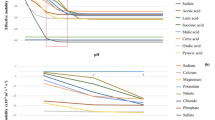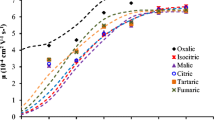Abstract
A capillary zone electrophoresis (CZE) method, optimised chemometrically, underwent a complete in-house validation protocol for the qualification and quantification of sucralose in various foodstuffs. Separation from matrix components was obtained in a dinitrobenzoic acid (3 mM)/sodium hydroxide (20 mM) background electrolyte with a pH of 12.1, a potential of 0.11 kV cm−1 and a temperature of 22 °C. Detection was achieved at 238 nm by indirect UV. Screening, optimisation and robustness testing were all carried out with the aid of experimental design. Using standard addition calibration, the CZE method has been applied to still, carbonated and alcoholic beverages, yoghurts and hard-boiled candy. The method allows the detection of sucralose at >30 mg kg−1, with a linearity range of 50–500 mg kg−1, making it suitable for implementation of the recently amended “Sweeteners for use in foodstuffs” Directive (European Parliament and Council (2003) Off J L237:3–12), which set maximum usable doses of sucralose for many foodstuffs, most ranging from 200 mg kg−1 to 450 mg kg−1.





Similar content being viewed by others
References
EC (2003) European Parliament and Council Directive 2003/115/EC; Amendment to European Parliament and Council Directive 94/35/EC on sweeteners for use in foodstuffs. Off J L114:15–17, L237:3–12
Tate & Lyle (2003) Analytical methodology: analysis of sucralose in food products. Pamphlet from Tate & Lyle, Reading, UK
Spangenberg B, Stroka J, Arranz I, Anklam E (2003) J Liquid Chromatogr R T 26:2729–2739
Dionex Corporation (2004) Dionex application note 159. Dionex Corporation, Sunnyvale, CA, USA
Stroka J, Dossi N, Anklam E (2003) Food Addit Contam 20:524–527
El Rassi Z (1996) Electrophoresis 17:275–437
Hoffstetter-Kuhn S, Paulus A, Gassmann E, Widmer HM (1991) Anal Chem 63:1541–1547
Wang T, Hartwick RA (1992) J Chromatogr 607:119–125
Nielen MWF (1991) J Chromatogr 588:321–326
Beck W, Engelhardt H (1992) Chromatographia 33:313–316
Vindevogel J, Sandra P (1991) Anal Chem 63:1530–1536
Rogan MM, Altria KD, Goodall DM (1994) Chromatographia 38:723–729
Ng CL, Lee HK, Li SFY (1993) J Chromatogr 598:133–138
Ng CL, Ong CP, Lee HK, Li SFY (1992) Chromatographia 34:166–172
Ng CL, Toh YL, Li SFY, Lee HK (1993) J Liquid Chromatogr 16:3653–3666
Altria KD, Filbey SD (1994) Chromatographia 39:306–310
Filbey SD, Altria KD (1994) J Capillary Electrop 1:190–195
Umetri AB (1998) Introduction to design of experiments. Umetri AB, Umea, Sweden
Mullholland M, Waterhouse J (1987) J Chromatogr 395:539–551
Andersson AM, Karlsson A, Josefson M, Gottfries J (1994) Chromatographia 38:715–722
Righezza M, Chretien JR (1993) Chromatographia 38:125–129
Berridge JC (1989) Chemometrics Intell Lab Syst 5:195–207
Mulholland M, Waterhouse J (1988) Chromatographia 25:769–774
Mulholland M (1988) Trends Anal Chem 7:383–389
Thomas BR, Ghodbane S (1993) J Liquid Chromatogr 16:1983–2006
EC (2002) European Parliament and Council Directive 2002/657/EC; implementing European Parliament and Council Directive 96/23/EC concerning the performance of analytical methods and the interpretation of results. Off J L:221/8
Thompson M, Ellison SLR, Wood R (2002) Pure Appl Chem 74(5):835–855
Quinlan ME, Jenner MR (1990) J Food Sci 55:1:244–246
Acknowledgements
The authors wish to express sincere gratitude to Dr. Mary Quinlan of Tate & Lyle for provision of pure sucralose and genuine samples, and to Dr. Fernando Cordeiro Raposo for advice on the use of chemometric experimental design for this optimisation.
Author information
Authors and Affiliations
Corresponding author
Rights and permissions
About this article
Cite this article
McCourt, J., Stroka, J. & Anklam, E. Experimental design-based development and single laboratory validation of a capillary zone electrophoresis method for the determination of the artificial sweetener sucralose in food matrices. Anal Bioanal Chem 382, 1269–1278 (2005). https://doi.org/10.1007/s00216-005-3258-5
Received:
Revised:
Accepted:
Published:
Issue Date:
DOI: https://doi.org/10.1007/s00216-005-3258-5




